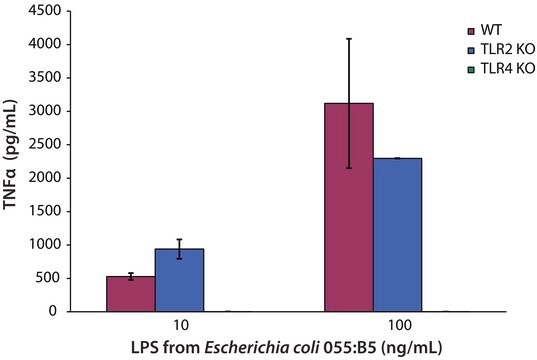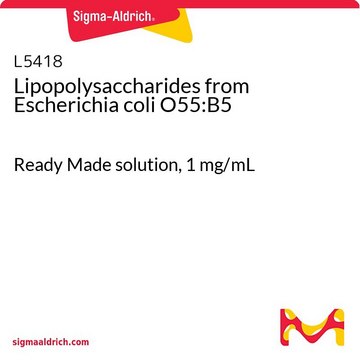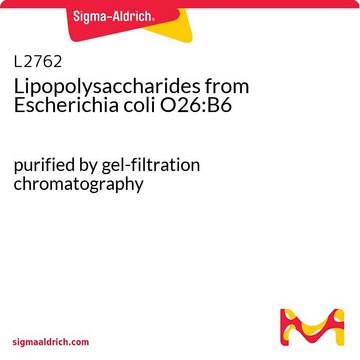F8666
Lipopolysaccharides from Escherichia coli O55:B5
FITC conjugate
Synonym(s):
LPS
Sign Into View Organizational & Contract Pricing
All Photos(2)
About This Item
Recommended Products
biological source
Escherichia coli (O55:B5)
Quality Level
conjugate
FITC conjugate
form
lyophilized powder
extent of labeling
2-10 μg FITC per mg LPS
color
yellow to orange
solubility
H2O: 4.90-5.10 mg/mL, faintly hazy to hazy, pale yellow to yellow
shipped in
ambient
storage temp.
2-8°C
Looking for similar products? Visit Product Comparison Guide
General description
This product is a TCA extract of E. coli serotype O55:B5 (strain CDC 1644-70), which was purified by gel filtration and conjugated to FITC (fluorescein isothiocyanate).
Application
FITC-Lipopolysaccharides (FITC-LPS) may be used to study the movement/transport of LPS across tissue barriers such as the colonic epithelium and cellular binding and internalization of lipopolysaccharides with fluorescence-based assay systems. FITC-LPS may be used to evaluate, qualify and quantify lipopolysaccharides (LPS) removal reagents and procedures. FITC-LPS conjugate may be used for the detection of LPA binding proteins and motifs.
Lipopolysaccharides (LPSs) are characteristic components of the cell wall of Gram-negative bacteria. LPS and its lipid A moiety stimulate cells of the innate immune system by the Toll-like receptor 4 (TLR4), a member of the Toll-like receptor protein family, which recognizes common pathogen-associated molecular-patterns (PAMPs).
Biochem/physiol Actions
Lipopolysaccharides (LPS) are localized in the outer layer of the membrane and are, in noncapsulated strains, exposed on the cell surface. They contribute to the integrity of the outer membrane, and protect the cell against the action of bile salts and lipophilic antibiotics.
Preparation Note
The product is soluble in water (5 mg/ml), yielding a hazy faint yellow solution. Lipopolysaccharides are molecules that form micelles in every solvent. Hazy solutions are observed in water and phosphate buffered saline. Organic solvents do not give clearer solutions. Methanol yields a turbid suspension with floaters, while water yields a homogeneously hazy solution.
Other Notes
To gain a comprehensive understanding of our extensive range of Lipopolysaccharides for your research, we encourage you to visit our Carbohydrates Category page.
related product
Product No.
Description
Pricing
Signal Word
Danger
Hazard Statements
Precautionary Statements
Hazard Classifications
Acute Tox. 2 Oral
Storage Class Code
6.1A - Combustible acute toxic Cat. 1 and 2 / very toxic hazardous materials
WGK
WGK 3
Flash Point(F)
Not applicable
Flash Point(C)
Not applicable
Personal Protective Equipment
dust mask type N95 (US), Eyeshields, Gloves
Choose from one of the most recent versions:
Already Own This Product?
Find documentation for the products that you have recently purchased in the Document Library.
Customers Also Viewed
Feifei Wang et al.
Sheng wu yi xue gong cheng xue za zhi = Journal of biomedical engineering = Shengwu yixue gongchengxue zazhi, 30(3), 635-640 (2013-07-20)
In order to remove the endotoxin from the blood of endotoxemia patients, we prepared a new adsorbent with heparin space arm and polymyxin B (PMB) ligand. The carrier of chloromethyl polystyrene resin was activated and heparin space arm was grafted
C Ganesh Kumar et al.
Enzyme and microbial technology, 55, 113-120 (2014-01-15)
In an ongoing survey for bioactive potential of microorganisms from different biosphere zones of India, a promising Kocuria rosea strain BS-1 was identified which produced an exopolysaccharide (designated as Kocuran) exhibiting in vitro antioxidant and immunosuppression properties. Kocuran was characterized
Yang Yu et al.
Scientific reports, 6, 20845-20845 (2016-02-10)
Phospholipid transfer protein (PLTP) participates in high density lipoprotein (HDL) metabolism. Increased plasma PLTP activity was observed in lipopolysaccharide (LPS) triggered acute inflammatory diseases. This study aimed to determine the exact role of PLTP in LPS induced inflammation. HDL pool
Elena Topchiy et al.
PloS one, 11(5), e0155030-e0155030 (2016-05-14)
Sepsis is the leading cause of death in critically ill patients. While decreased Proprotein Convertase Subtilisin/Kexin type 9 (PCSK9) function improves clinical outcomes in murine and human sepsis, the mechanisms involved have not been fully elucidated. We tested the hypothesis
Bin Li et al.
International journal of molecular sciences, 15(1), 1143-1161 (2014-01-21)
Innate immunity is the first line of defense in human beings against pathogen infection; monocytes/macrophages are the primary cells of the innate immune system. Recently, macrophages/monocytes have been discovered to participate in LPS clearance, and the clearance efficiency determines the
Our team of scientists has experience in all areas of research including Life Science, Material Science, Chemical Synthesis, Chromatography, Analytical and many others.
Contact Technical Service




